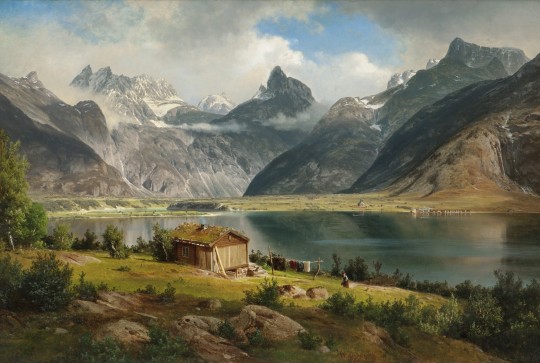#johan fredrik eckersberg
Text

Valley of Romsdalen by Johan Fredrik Eckersberg
#johan fredrik eckersberg#art#romsdalen#valley#norway#norwegian#landscape#nature#mountains#mountain#europe#european#scandinavia#scandinavian#northern europe#clouds
414 notes
·
View notes
Photo

Johan Fredrik Eckersberg (1822–1870)
3 notes
·
View notes
Text

Johan Fredrik Eckersberg (Norwegian, 1822-1870)
View in Sørfjorden, Hardanger
signed and dated 'J F Eckersberg./1863' (lower right)
oil on canvas
Bonhams
4 notes
·
View notes
Text

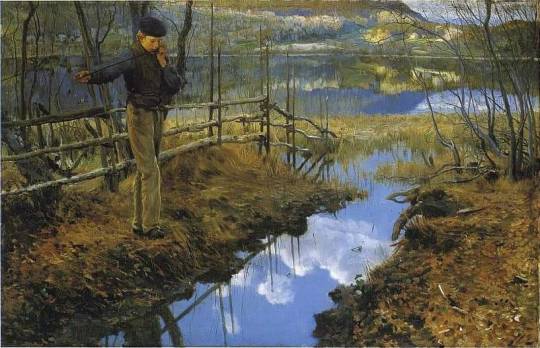

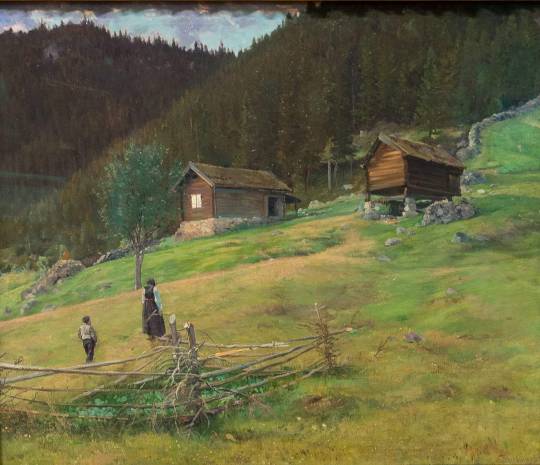

"Christian Skredsvig (12 March 1854 – 19 January 1924) was a Norwegian painter and writer. He employed an artistic style reflecting naturalism. He is especially well known for his picturesque and lyrical depictions of the landscape. He was born and grew up on the Skredsvig farm in the parish of Modum in Buskerud, Norway.
When he was 15 years old he became a pupil at the drawing and paint school of Johan Fredrik Eckersberg in Christiania. After Eckersberg's death in 1870 he studied with Julius Middelthun at Norwegian National Academy of Craft and Art Industry (Den kgl. Tegneskole) in Kristiania (now Oslo). He followed with four years of apprenticeship (1870–1874) in Copenhagen under the supervision of landscape painter Vilhelm Kyhn at the Royal Danish Academy of Fine Arts.
After several years in Paris he moved back to Norway in 1886 and settled at the Fleskum farm in Bærum. His new home became a gathering place for painters, poets and musicians. Eilif Peterssen, Kitty Kielland, Harriet Backer and Erik Werenskiold all made trips to the farm. Skredsvig's famous neo-romantic painting Seljefløiten (1889) was painted by the Lake Dælivannet in Bærum. He also conducted study trips, to Corsica in 1888 and to southern France in 1891.
In 1894, he moved to Eggedal in Sigdal municipality where he built his home Hagan. In the natural landscape of Eggedal, Skredsvig found inspiration and motives to paint".
> Pomah Konomieub > Painters from the North
4 notes
·
View notes
Photo

7Now Samuel did not yet know the Lord: The word of the Lord had not yet been revealed to him.
Eckersberg, Johan Fredrik (1822-1870)
People in Sørfjorden (the Southern Fiord), Hardanger 1860
1 note
·
View note
Text

Valley of Romsdalen (1857) - Johan Fredrik Eckersberg
1 note
·
View note
Text

Fra Romsdalen, Johan Fredrik Eckersberg
0 notes
Photo
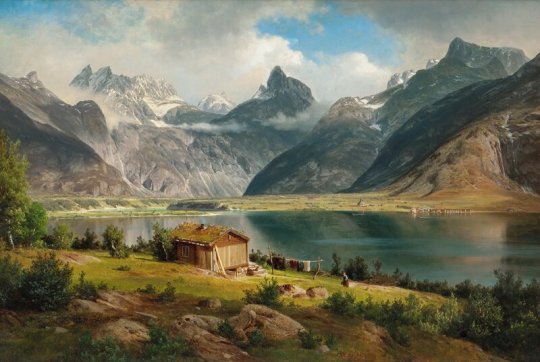
25Now large crowds were traveling with him; and he turned and said to them, Verse26"Whoever comes to me and does not hate father and mother, wife and children, brothers and sisters, yes, and even life itself, cannot be my disciple. Verse27Whoever does not carry the cross and follow me cannot be my disciple. Verse28For which of you, intending to build a tower, does not first sit down and estimate the cost, to see whether he has enough to complete it? Verse29Otherwise, when he has laid a foundation and is not able to finish, all who see it will begin to ridicule him, Verse30saying, 'This fellow began to build and was not able to finish.' Verse31Or what king, going out to wage war against another king, will not sit down first and consider whether he is able with ten thousand to oppose the one who comes against him with twenty thousand? Verse32If he cannot, then, while the other is still far away, he sends a delegation and asks for the terms of peace. Verse33So therefore, none of you can become my disciple if you do not give up all your possessions.
1 All to Jesus I surrender;
All to Him I freely give;
I will ever love and trust Him,
In His presence daily live.
Refrain:
I surrender all,
I surrender all;
All to Thee, my blessed Savior,
I surrender all.
2 All to Jesus I surrender;
Humbly at His feet I bow,
Worldly pleasures all forsaken;
Take me, Jesus, take me now. [Refrain]
3 All to Jesus I surrender;
Make me, Savior, wholly Thine;
Let me feel the Holy Spirit,
Truly know that Thou art mine. [Refrain]
4 All to Jesus I surrender;
Lord, I give myself to Thee;
Fill me with Thy love and power;
Let Thy blessing fall on me. [Refrain]
5 All to Jesus I surrender;
Now I feel the sacred flame.
Oh, the joy of full salvation!
Glory, glory, to His Name!
Eckersberg, Johan Fredrik (1822-1870)
Romsdalshorn 1867
1 note
·
View note
Photo
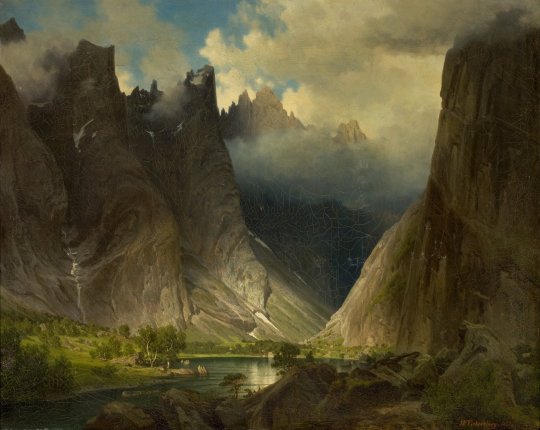
Johan Fredrik Eckersberg (Norwegian, 1822-1870), "Valley of Romsdalen" (1857)
Oil on canvas, 58.4 x 71.1 cm
Private collection
4 notes
·
View notes
Photo
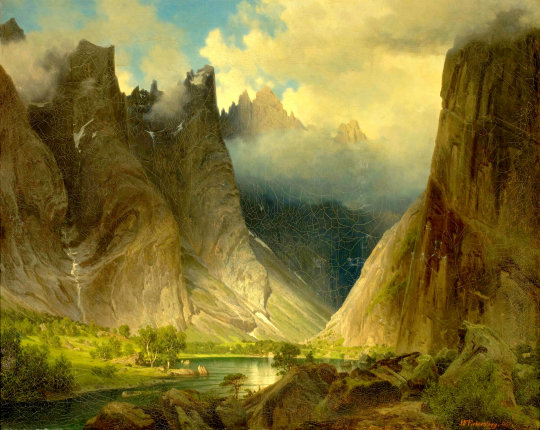
Johan Fredrik Eckersberg (1822 – 1870)
Valley of Romsdalen, 1857
257 notes
·
View notes
Photo
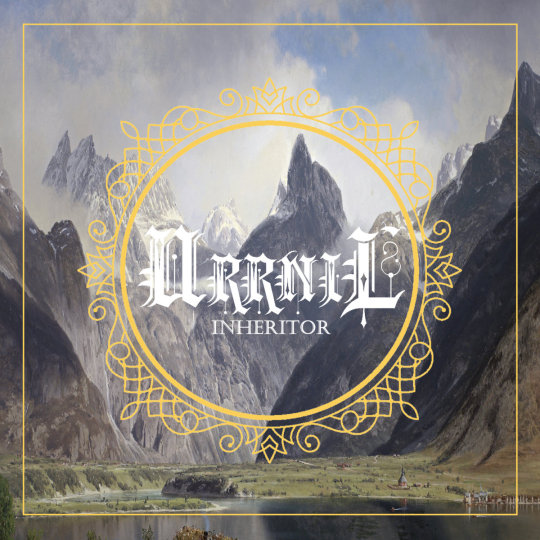
Urrnil | Inheritor (2018)
4 notes
·
View notes
Photo

https://ift.tt/2BEGQws @WilhelmGustloff: Johan Fredrik Eckersberg View from Bøverdalen 1868 @MagicalEurope https://t.co/ndmf2k3Yrt https://ift.tt/39Az1oe
0 notes
Photo

Johan Fredrik Eckersberg (1822-1870)
Illustrasjon til det norske folkeeventyret “Bjørnen og reven vedder om flesk og humlebol” fra Asbjørnsen & Moe.
Les eventyret på EventyrForAlle.no:
https://eventyrforalle.no/asbjornsen-moe/am080
Illustration for the Norwegian folk tale “Pork and Honey” from Asbjørnsen & Moe.
#eventyr#fairy tales#illustrasjoner#illustrations#johan fredrik eckersberg#asbjørnsen og moe#asbjørnsen and moe#asbjornsen and moe#folkeeventyr#folklore#folktales#folk tales#bjørnen og reven vedder om flesk og humlebol#bjørnen og reven#pork and honey#the bear and the fox who made a bet
0 notes
Text
Cultured Wednesday: Eckersberg's Fra Romsdalen
Cultured Wednesday: Eckersberg’s Fra Romsdalen
Now here’s a place to live in these days: Across the lake from town. Looks like a lovely little cottage to me. Talk about social distancing! (Click the picture for a closer look.)
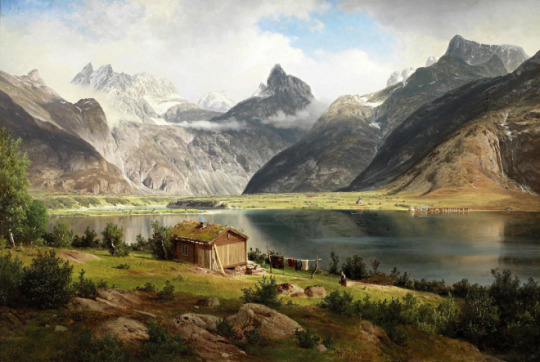
Fra Romsdalen. Romsdalen is the valley (or dale) of the Rauma river in western Norway.
Johan Fredrik Eckersberg(16 June 1822 – 13 July 1870) was a Norwegian landscape painter and teacher at his own art school in…
View On WordPress
#19th century painters#Art#entertainment#Johan Eckersberg#Norwegian landscape painter#Norwegian painter#Norwegian Realism#Norwegian Romanticism#Romsdalen
0 notes
Text
jonathan zawada
Jonathan Zawada spoke on his commercial and artistic works, particularly his 3D renders. He introduced with the idea of “delaying decisions and preserving possibilities”. This stuck out to me as an unusual approach to artmaking as most often creators are driven by the end result or at the very least a vague image of the ideal final outcome. He spoke about the nature of the digital age and moving away from methods of linear creative planning and moodboards that are used in commercial work. Digital imagery is free to make, less limiting and more expansive - infinite possibilities for outcomes.
His attitude towards a lot of commercial practices was that it is reductive as it did not accommodate for the infinite number of potential outcomes for his 3D renders and in turn Zawada sees it as limiting. Both Amrita Hepi and Jonathan Zawada spoke about the transience of art. While Hepi spoke about how dance is hard to commodify, Zawada’s digital renders have infinite possibilities therefore each image has unique value and the ability to be infinitely reproduced and tweaked. The nature of his work disrupts the traditional means of, and limits to, creating and acquiring art.
Zawada’s works, however unrealistic in the wild colour schemes, provoke visceral reactions in the audience as they are reminiscent of the splendor and pure beauty of earth’s landscapes. His methods of creating works contrast this idea of the natural world and its affecting abilities as they are digitally created using mathematical data in a seemingly impersonal digital process.
While his renders are driven by his personal instinctive creativity, his lack of vision for a final result (“preserving possibilities”) seems inhuman, lacking the personal touch or manually laborious process of a Renaissance oil painting which many of his works visually parallel.

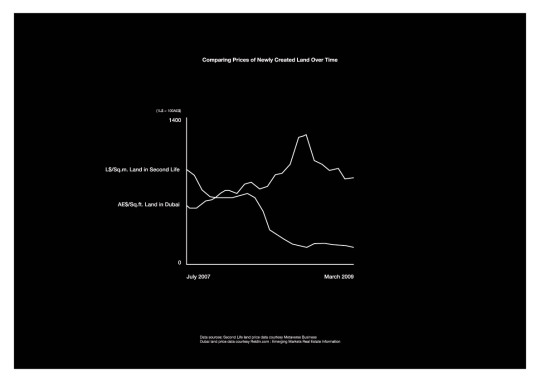
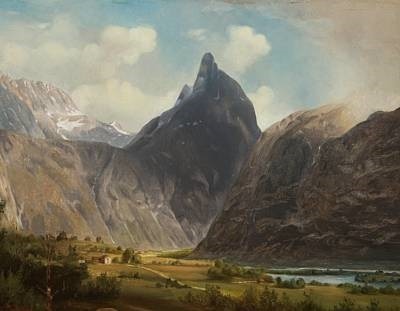
Top: Jonathan Zawada, Over Time, 2010-2011 - “Landscape topographies derived from graph data were modeled in 3D and then oil paintings created from those 3D renders.” https://www.formagramma.com/art/8446/over-time-jonathan-zawada/
Bottom: Johan Fredrik Eckersberg, Romsdalshorn, 1857 - oil on board
I believe the seemingly impersonal ways in which he creates and the nature of his digital renders actually serve to highlight the emotionality of human nature. Despite the digital process, we still experience his images as deeply moving as they are immensely visceral and hold emotional gravitas. We easily overlook the “unreal” digital elements of his images due to the hypnotic beauty and profoundly moving nature of the uncanny fictional landscapes despite being an entirely fictitious scene in a non tangible format.

The Four Worlds, 2018 http://zawada.art/2018/09/04/mark-pritchard-the-four-worlds/
0 notes
